
|
|
FYBUSH.COM/SITE OF THE WEEK
NEEDS YOUR SUPPORT! (AND YOU CAN GET A FREE TOWER SITE CALENDAR
IF YOU PLEDGE NOW...) CLICK HERE TO
LEARN MORE...
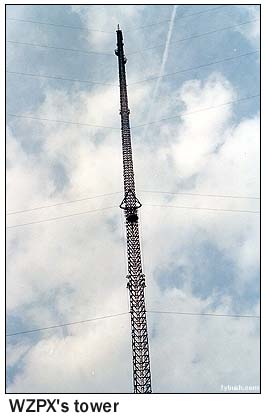 November 27 - December 4, 2003
November 27 - December 4, 2003
High Power in West Michigan
Think of West Michigan - that broad swath that stretches from Battle Creek west to Kalamazoo and Benton Harbor and north to Grand Rapids, Muskegon and beyond - and perhaps you think of our nation's 37th president, Grand Rapids' own Gerald R. Ford. Or maybe you think of the Kellogg's cereal that put Battle Creek on the map. Or, if you're the kind of person who reads Tower Site of the Week (and clearly you are), you let out a long, low whistle and say, "There are some powerful FM stations there!"
And indeed there are - in fact, one of those FM stations once ran at 500 kilowatts ERP, the highest power ever used by an FM broadcaster in North America. We'll see its descendant in just a moment, but first a little detour.
You see, West Michigan is also the home of some of the friendliest broadcast engineers anywhere. Tom Bosscher got my attention a few years ago when he set out on the noble quest to photograph (almost) every broadcast tower in Michigan, a project whose results you can see on Tom's Michigan Broadcast Towers page. (Please don't forget to come back here after you've spent some serious time there!)
A few years ago, Tom invited me to come up and get to know West Michigan's towers better, and I came very close to making that trip last year, only to be thwarted by miserable snowy weather that kept me stuck in Fort Wayne, Indiana. But when I was planning a return visit to Fort Wayne with the new baby, a side trip to West Michigan was clearly in order - even more so when Dick Castanie, chief engineer of Pax's WZPX (Channel 43) in Battle Creek also checked in with an invitation to see the sites.
So, accompanied by Indiana Radio Watch editor Blaine Thompson, your editor set out at the end of October to see how much of West Michigan he could absorb in one day with the help of some good tour guides.
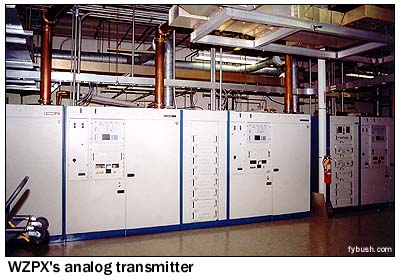 |
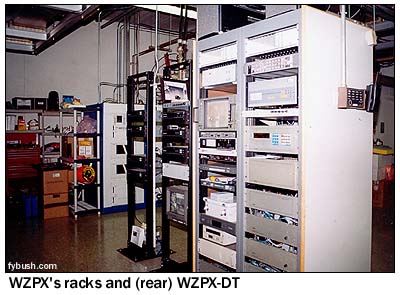
|
After an auroral evening's drive up I-69, I-94 and US 131 and a night in Plainwell, north of Kalamazoo, we started our day out at Dick's WZPX site in remote Vermontville (east of Hastings), a spot chosen to provide coverage of Grand Rapids, Kalamazoo, Battle Creek and the adjacent Lansing market. This site went on the air in the fall of 1996 as independent WJUE, changing hands two years later and becoming first WILV and then WZPX under Pax.
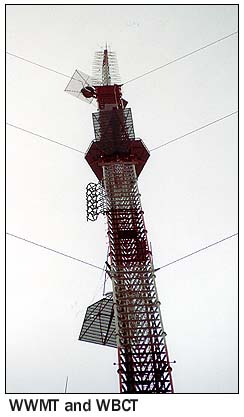 Dick
takes a lot of pride in his site - you can see just how much
if you check out WZPX's amazing engineering
Web pages, including live camera views of the transmitter
room and live transmitter readings (!) The big Comark transmitters
shown above at left are for the analog signal on channel 43;
WZPX-DT 44 uses the smaller Comark tucked behind the engineering
racks at right, and they both share the 1000-foot (1059' to the
top of the antenna) Pirod tower at the top of the page.
Dick
takes a lot of pride in his site - you can see just how much
if you check out WZPX's amazing engineering
Web pages, including live camera views of the transmitter
room and live transmitter readings (!) The big Comark transmitters
shown above at left are for the analog signal on channel 43;
WZPX-DT 44 uses the smaller Comark tucked behind the engineering
racks at right, and they both share the 1000-foot (1059' to the
top of the antenna) Pirod tower at the top of the page.
From WZPX, we head west again, back through Hastings to the Gun Lake area, just east of US 131 about halfway between Grand Rapids and Kalamazoo. It's here that we find the home of WWMT (Channel 3) and WBCT (93.7), the site that was home to that half-megawatt FM station all those years ago.
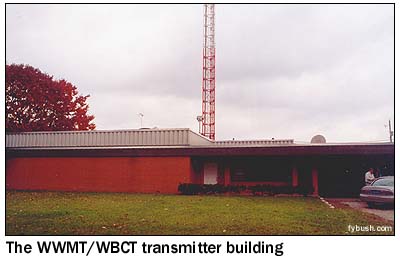 Back
then, the FM station's call letters were WJEF-FM, which stood
for John E. Fetzer, the Michigan broadcast magnate who controlled
several powerful signals in the region. In Kalamazoo, he owned
dominant AM station WKZO (590), which was joined in 1950 by WKZO-TV
on channel 3, then operating from a short tower that gave it
coverage of Kalamazoo and Battle Creek but not of Grand Rapids,
some 50 miles to the north. (Grand Rapids had its own single
station, WLAV-TV 7, and we'll see what happened to it next
week.)
Back
then, the FM station's call letters were WJEF-FM, which stood
for John E. Fetzer, the Michigan broadcast magnate who controlled
several powerful signals in the region. In Kalamazoo, he owned
dominant AM station WKZO (590), which was joined in 1950 by WKZO-TV
on channel 3, then operating from a short tower that gave it
coverage of Kalamazoo and Battle Creek but not of Grand Rapids,
some 50 miles to the north. (Grand Rapids had its own single
station, WLAV-TV 7, and we'll see what happened to it next
week.)
Fetzer also had a radio station in Grand Rapids, WJEF (1230), which was granted an FM construction permit in 1946 at 49.3 megacycles, later changed to 93.7, with the unheard-of (and at the time unbuildable) power of 550 kilowatts ERP. It lingered unbuilt for several years, finally signing on in 1951 from the Kalamazoo WKZO-TV site with 115 kilowatts.
And then, in 1960, Fetzer decided to turn West Michigan into one big TV market, moving WKZO-TV some 25 miles north to Gun Lake, where he built an 1100-foot tower for channel 3 and his FM operation, which was limping along in those dark days for FM radio. With the purchase of new transmitting gear for WKZO-TV at the new site, the old RCA TT-25AL TV power amplifiers that had been used for channel 3 at Kalamazoo were about to become available, and so the dream of 500,000 watts became a reality.
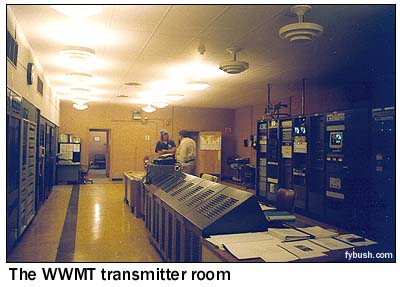
|
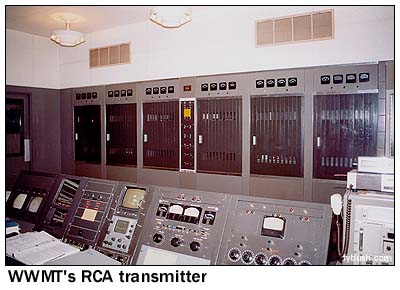
|
The new WJEF-FM operation used an RCA BTF-10D 10kW transmitter to drive the two 25kW power amplifiers, creating the first BTF-50B transmitter, which fed a 12-bay antenna 800 feet up on the tower that gave WJEF-FM 90 miles of solid coverage in every direction, especially in those days when the FM dial was a vast empty space. (Even so, the profit in running that huge transmitter was mainly in the station's Muzak franchise; the main carrier was nearly an afterthought, programming beautiful music most of the time. Engineers of the time recall playing a specially-chosen list of records on the main carrier to entertain Mrs. Fetzer's guests when she'd hold dinner parties on Saturday nights, in what must have been the most elaborate "home entertainment system" in history!)
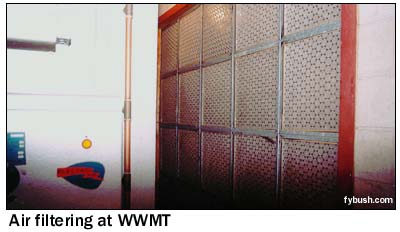 The
transmitter building itself was - and is - impressive. Upon entering
the transmitter room, the first thing that struck us was how
quiet it was. There's a good reason for that: instead of having
noisy blowers mounted on each transmitter, there's a vent that
goes from each transmitter to an L-shaped room in the basement.
In the corner of that room, a small closet-sized chamber draws
air in from the outside, passes it through a wall of air filters
(at left), then blows it out into the ventilation room. Presto:
clean air and no noise upstairs.
The
transmitter building itself was - and is - impressive. Upon entering
the transmitter room, the first thing that struck us was how
quiet it was. There's a good reason for that: instead of having
noisy blowers mounted on each transmitter, there's a vent that
goes from each transmitter to an L-shaped room in the basement.
In the corner of that room, a small closet-sized chamber draws
air in from the outside, passes it through a wall of air filters
(at left), then blows it out into the ventilation room. Presto:
clean air and no noise upstairs.
Today, of course, the BTF-50B is history, replaced by a much smaller pair of Harris 25kW transmitters that combine to make 50 kW(and when was the last time you saw a 50 kW FM transmitter, anyway?) A 12-bay ERI antenna on the channel 3 tower (that's the 6-bay aux you see above) carries 93.7 out to West Michigan, now with 320 kW of effective radiated power, which is still awfully impressive. (Alas, the grandfathering of the pre-1964 superpower stations like this one means they're no longer protected from interference beyond the normal contours of a 50 kW class B FM station, so 93.7 - later known as WJFM and now Clear Channel country outlet WBCT - has had the fringes of its enormous coverage area bitten into by a slew of drop-in allocations.)
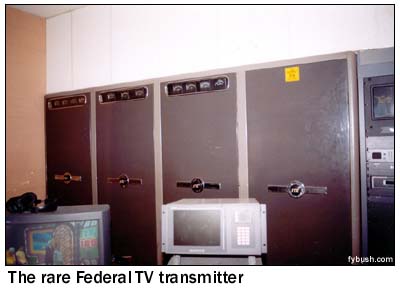 There's
still more unusual history at this site: tucked back in a corner
of the transmitter room (and don't you just love those funky
fifties lighting fixtures?) is what looks like an old Federal
FM transmitter.
There's
still more unusual history at this site: tucked back in a corner
of the transmitter room (and don't you just love those funky
fifties lighting fixtures?) is what looks like an old Federal
FM transmitter.
It's actually something else - a Federal TV transmitter, apparently a one of a kind modification of the familiar Federal FM boxes that powered so many early FM signals. (Hey, if Fetzer could run his FM off a converted TV transmitter, why not run his TV off a converted FM transmitter?)
The engineers at channel 3 say this unit even passed color, once upon a time.
Today, of course, channel 3 uses something more modern to generate its signal - a Harris solid-state transmitter, seen just to the right of the old RCA in the transmitter room wide shot above.
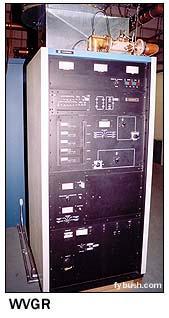 And the CBS affiliate
- which changed calls to WWMT ("West Michigan Television")
when it was sold off separately from WKZO radio in the seventies
- has digital TV now, of course. WWMT-DT operates on channel
2 from a Harris solid-state unit just to the right of the Federal;
it's diplexed into the big batwing channel 3 antenna at the top
of the tower.
And the CBS affiliate
- which changed calls to WWMT ("West Michigan Television")
when it was sold off separately from WKZO radio in the seventies
- has digital TV now, of course. WWMT-DT operates on channel
2 from a Harris solid-state unit just to the right of the Federal;
it's diplexed into the big batwing channel 3 antenna at the top
of the tower.
There's one more station that calls this site home these days. WVGR (104.1 Grand Rapids) is the West Michigan voice of the University of Michigan's "Michigan Radio" public radio network. (The "V" stands for Vogt, the man who led the campaign to bring public radio to the region.) Since 1961, it's simulcast WUOM (91.7) from Ann Arbor, operating for most of that time from the WOOD-TV (Channel 8) tower that we'll see next week.
A couple of years ago, though, the rent went up over at WOOD, and WVGR moved out. The station is making plans to build its own tower somewhere in the Gun Lake area, but for now its grandfathered 108 kW signal comes from an antenna mounted on the WWMT tower and from this Harris transmitter tucked in the back room behind WWMT's old RCA. (There's also an old RCA that WVGR uses as an auxiliary.)
That's a lot of history for one site, isn't it? But there's still a lot more to see in West Michigan - and we'll continue next week with the story of Grand Rapids' second FM station - and of a lot of stations called "WOOD," too!
Tower Site Calendar 2004 is NOW AVAILABLE! Click here for advance ordering information!
- Previous Site of the Week: Empire State Building Today
- Next Week: West Michigan, part 2
- Site of the Week INDEX!
- How can you help support Site of the Week? Click here!
- Submit your suggestions for a future Site of the Week!
